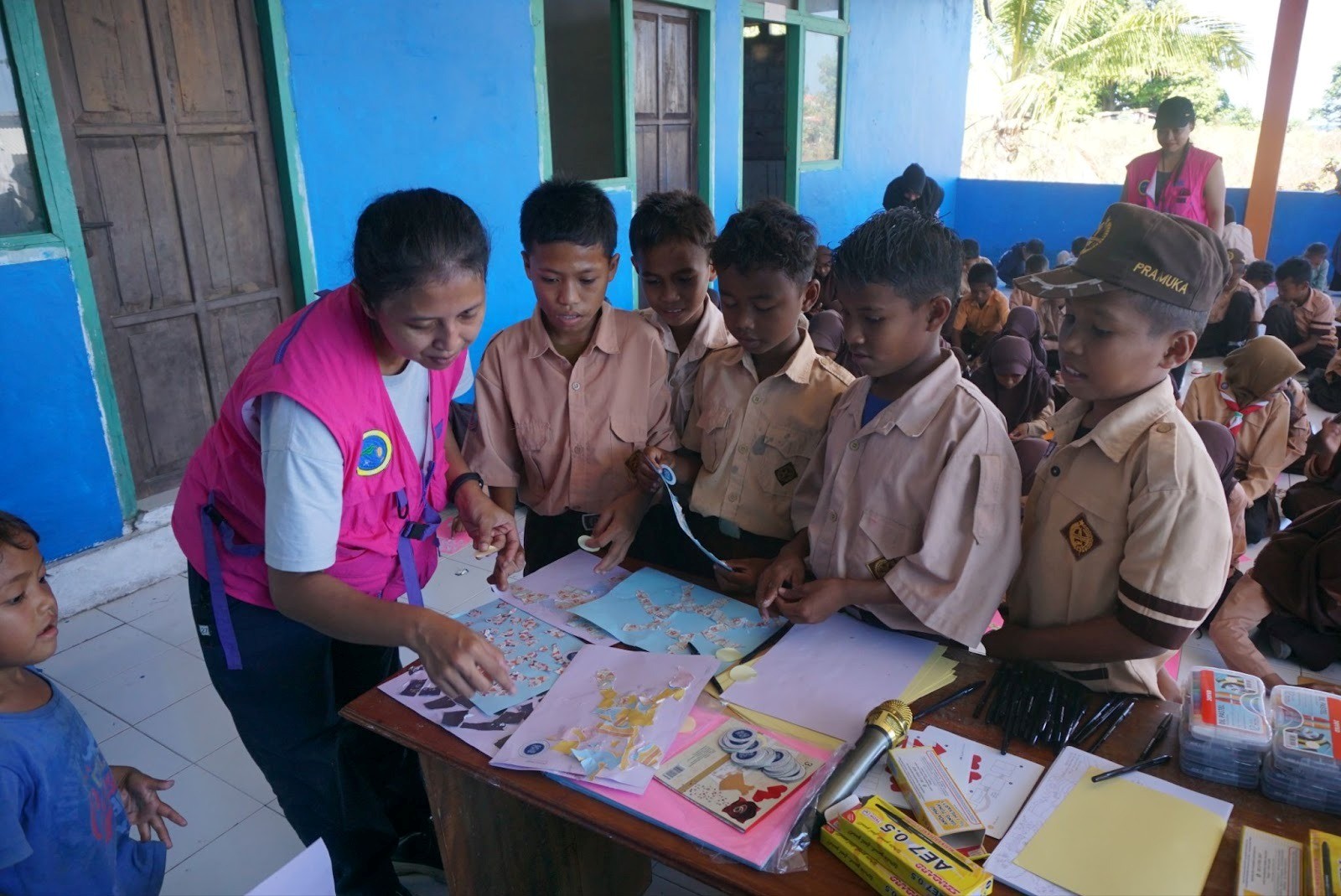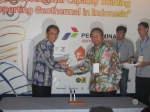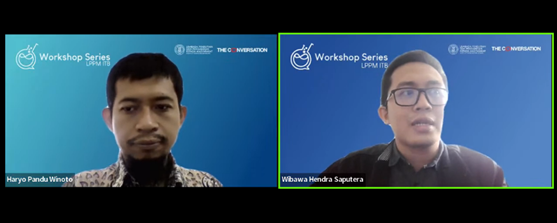Fusing Art and Science to Reduce Earthquake and Tsunami Risks at Lebak Coast, Banten
By Adi Permana
Editor Adi Permana
BANDUNG, itb.ac.id—Indonesia's coastal zones are prone to earthquakes and tsunamis, one of which is the southern coastline of Lebak Regency, Banten. Published studies of ITB, BRIN, BMKG and BNPB stated that megathrust earthquakes can reach magnitudes of 8.9 and trigger 20-meters tall tsunamis.
To lower public unrest of these hazards, GMLS (South Lebak Mitigation Cluster) requested the support of many to improve their risk reduction capacity. "Communities on the south coast of Lebak do not have enough resilience to act, even before the disaster arrives," Abah Lala, the community leader of GMLS, stated.
On Sunday (7/2/2021), discussions between GMLS, ITB Global Geophysics Research Group, BRIN (formerly LIPI), and U-INSPIRE were initiated as efforts to strengthen the community. The ITB team carried out community service, mapping out residential areas in Cimampang and Sukarena/Cikumpay, modeling tsunami inundation, recording exposure with UAVs, designing public information boards, surveying the condition of village resources, and digitizing evacuation route maps.
This program was held until 2022. Through collaboration with various parties, ITB helps coastal residents of South Lebak to build their readiness through activities that refer to indicators set by the Disaster Resilient Villages program, UNESCO-IOC Tsunami Ready, and SPAB (Education Safety on Disasters). The activities chosen as the focus are the capacity building of GMLS and schools with a pilot project at SMA Negeri 1 Panggarangan. The school was chosen because it is only 300 meters from the waterfront, making it in the red zone of the tsunami bath. This condition is aggravated by the absence of barriers or rows of vegetation that can dampen the pace of waves at the school.
From June 28 to July 6, 2022, several lecturers and students from the Geophysical Engineering, Visual Design, and Communication Study Program teamed up with PRKG BRIN researchers and members of U-INSPIRE Indonesia to compile a series of activities to strengthen community capacity and reduce disaster risk. This community service also cooperated with PMI and Panggarangan Village Public Health Center to provide first-aid training.
The program began with understanding and expressing the topics based on science, art, and local teachings. The natural process of earthquakes and tsunamis were taught to locals. Representatives from nearby communities also shared their traditions of Caah Laut, which means the tidal floods phenomenon and interpreted more broadly as the arrival of seawater to land in the past. Nowadays, locals of Lebak believe that Caah Laut and the tsunami have similar contexts.
Collaborative Efforts to Build Long-Term Resilience
The community service program participated by ITB was successfully formed in collaboration with many parties in 2021, either online or offline. Socialization of earthquake-tsunami mitigation and assessment of public readiness was conducted at SMA Negeri 1 Panggarangan using the STEP-A method. This method was offered from the official BNPB application and was developed by UNDP Indonesia, UNESCO, BRIN (formerly LIPI and BPPT), ITB, and more. It is hoped that this STEP-A application can prepare schools to face incoming natural disasters, as mentioned as one of the government's focuses through the SPAB National Secretariat.
Based on the assessment results released on June 15, 2021, the academic staff and the 35 students at SMA Negeri 1 Panggarangan do not know much about anticipating natural disasters. The resulting parameters of the school's emergency response plan and early warning system are also considered low. Thus, improving the educational aspect is necessary to mitigate disaster.
As a follow-up, the school took the initiative in March 2022 to establish a disaster mitigation unit with the support of ITB, BRIN, and GMLS. They also prepared the SOPs that were tested using TTS (Tabletop Simulation) activities. Roles included in the TTS are those in the evacuation, security, health, logistics, information dissemination, and preparedness sectors. Other roles found in the academic sectors are teachers, students, student council presidents, and more.
Commencing Simulation and Emergency Response Posts
Coordination between GMLS and the school dean is needed during a disaster. When the simulation is carried out, all elements and conditions that require preparations become the main objective to allow a more directed and structured evacuation procedure. The location of the schools in Sukajadi Village is equally important; reaching the DES (Designated Evacuation Site) at the GMLS Command Center of Kiarapayung Village would require all school personnel to pass through Hegarmanah Village. Bureaucratically, the schools’ SOP must include the DES so that there is administrative clarity in line with the village’s governmental responsibilities.
BMKG also participated in the evacuation simulation. As an observer who has the authority to signal early disaster warnings, Urip Setiyono (Head of Data and Information Section of BMKG Tangerang Geophysical Station) noticed the lack of response from the locals when information regarding aftershocks was shared.
"Evacuated people walked through sandy roads, which amplified the earthquake," he explained. PRKG BRIN researcher Rahma Hanifa confirmed this statement, sharing her experience of a 9.0 earthquake magnitude in Japan, in 2011. She recounted how difficult it was to stand during aftershocks that happen almost every 5 minutes. Staff from the RAPI and Communication were present as well to fulfill the communication needs of the residents.
After the participants arrived at the DES, they proceeded with pitching tents, arranging accommodation, and managing kitchens with the help of the Supply Transport Detachment of Korem 064/Maulana Yusuf. U-INSPIRE Indonesia and PMI also assisted in conducting data collection and triage of health.
The Role of Art in Educating Disaster Mitigation
The perception and understanding of natural disasters in schools are strengthened through simulations and artistic expressions. With the guidance of ITB FAD students and lecturers, they compiled materials about the sustainability of disaster risk reduction efforts on school grounds, with the final three materials successfully created and combined with art. The first material was published as the "Education on Sea Heritage" book, containing local stories and wisdom related to the tsunami and students’ experiences in its evacuation and displacement simulation.
The second work is a dance accompanied by Sundanese songs. It was written, sung, and performed by the students. Lastly, an installation titled "Mitigarium'' was held, showcasing objects found in the school. Expressions of the tsunami’s aftermath and atmosphere are depicted through the arrangement of these objects.

*This article has been published in the ITB Engineering rubric of Media Indonesia. The full article can be read on https://pengabdian.lppm.itb.ac.id
Reporter: Sekar Dianwidi Bisowarno (Bioengineering, 2019)
Translator: Ruth Nathania (Environmental Engineering, 2019)

.jpg)
.jpg)


.jpg)


